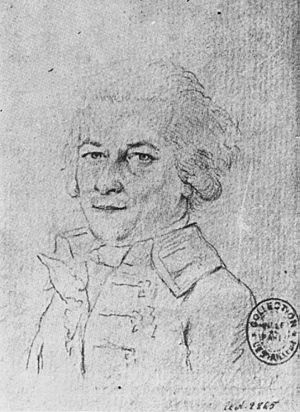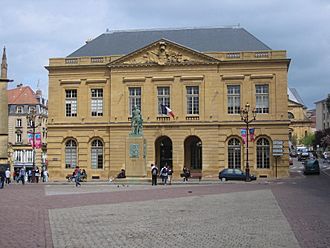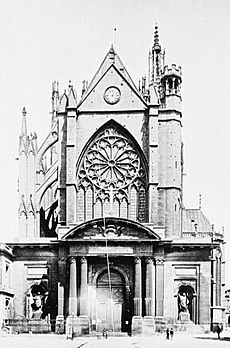Jacques-François Blondel facts for kids
Quick facts for kids
Jacques-François Blondel
|
|
|---|---|

Blondel in a c. 1760 illustration
|
|
| Born | 8 January 1705 |
| Died | 9 January 1774 (aged 69) Louvre Palace, Paris, France
|
| Occupation | Architect |
| Spouse(s) |
|
| Practice | Neoclassicism |
Jacques-François Blondel (born January 8, 1705 – died January 9, 1774) was an important French architect and teacher in the 1700s. He ran his own very successful school for many years. Later, he became a Professor of Architecture at the Académie Royale d'Architecture in 1762. His book, Cours d'architecture (which means "Course of Architecture"), published between 1771 and 1777, became more popular than a similar book by another famous architect named François Blondel.
Contents
Blondel's Early Life and Training

Jacques-François Blondel was born in Rouen, France. He first learned about architecture from his uncle, Jean-François Blondel. His uncle was also an architect in Rouen.
By 1726, Jacques-François moved to Paris. There, he continued his studies with Gilles-Marie Oppenord. From Oppenord, he learned about the rococo style of art and architecture. He also worked with Jean Mariette, helping with his book L'Architecture françoise. Blondel wrote parts of the book and created architectural drawings for it.
Blondel became a careful and traditional architect. He liked to keep French classical architecture organized and clear.
Important Books and Teaching
De la Distribution des Maisons de Plaisance
Blondel's first book was called De la Distribution des Maisons de Plaisance, et de la Décoration des Edifices en General. This long title means "On the Arrangement of Country Houses, and the Decoration of Buildings in General." It was published in Paris between 1737 and 1738. This book was very influential and had 155 detailed drawings.
His book and other drawings led to a special job. He was asked to create thirteen drawings for a book celebrating a royal wedding. This book marked the marriage of Louise Élisabeth of France to Philip, Duke of Parma.
Blondel's Private School
In 1740, Blondel opened his own private school in Paris. It was called the École des Arts. The Académie, a famous art institution, approved his school in 1743. Many future architects learned from him at this school.
Some of his famous students included Étienne-Louis Boullée, Claude Nicolas Ledoux, and William Chambers. These students later became important architects themselves. Blondel was known as the most important French architecture teacher of his time. He wanted to create clear rules for designing homes. These rules would match the classical ideas already used for public buildings.
Architecture françoise
Blondel wrote another important four-volume book called Architecture françoise. It was published from 1752 to 1756. In this book, he wrote about French buildings from the past century, especially those in and around Paris. He explained their history and gave many details that might have been lost otherwise.
In the introduction, he said he used "simple terms and a popular style." He wanted both regular people and artists to understand his work. He had noticed that other architecture books were often confusing or too long. He had planned to write eight volumes, but only the first four were published.
This book brought him to the attention of important people. In 1755, he joined the Académie Royale d'Architecture. He was also appointed as an architect to King Louis XV of France.
Later Works and Teaching at the Académie
Blondel did not design many buildings himself. Most of his work was in Metz for the duc de Choiseul. However, his ideas were very strong and well-thought-out. He even wrote articles for Diderot's famous Encyclopédie. He wrote about masonry (building with stone) and architecture. He contributed almost 500 articles to the Encyclopédie until his death in 1774.
In 1762, he became a Professor of Architecture at the Académie. He closed his own school and brought his complete teaching program to the Académie. His book Cours d'architecture began to be published in 1771. It eventually grew to nine volumes by 1777. His student Pierre Patte helped finish the last volumes after Blondel's death. This Cours d'architecture is sometimes called the "Petit Blondel." This helps tell it apart from his earlier "Grand Blondel," which was Architecture françoise.
Blondel's practical way of teaching and writing about architecture was very important. He mostly ignored the fancy style of Rococo. His ideas stayed popular in French architectural training for many decades.
Blondel's Family Life
Blondel married Marie Anne Garnier in 1729. Their son, Georges-François Blondel, was born in 1730. He also became an architectural engraver, making detailed drawings for buildings. They also had a daughter named Claudine Angelique.
After his first wife passed away in 1755, Jacques-François married Manon Balletti in 1760. Their son, Jean-Baptiste Blondel, was born in 1764. Jean-Baptiste later became an architect for the city of Paris.
During his last illness, Jacques-François asked to be taken to his classrooms at the Louvre Palace. He died there, surrounded by his books, his architectural models, and his students. This shows how much he loved teaching and architecture.
See also
 In Spanish: Jacques-François Blondel para niños
In Spanish: Jacques-François Blondel para niños


